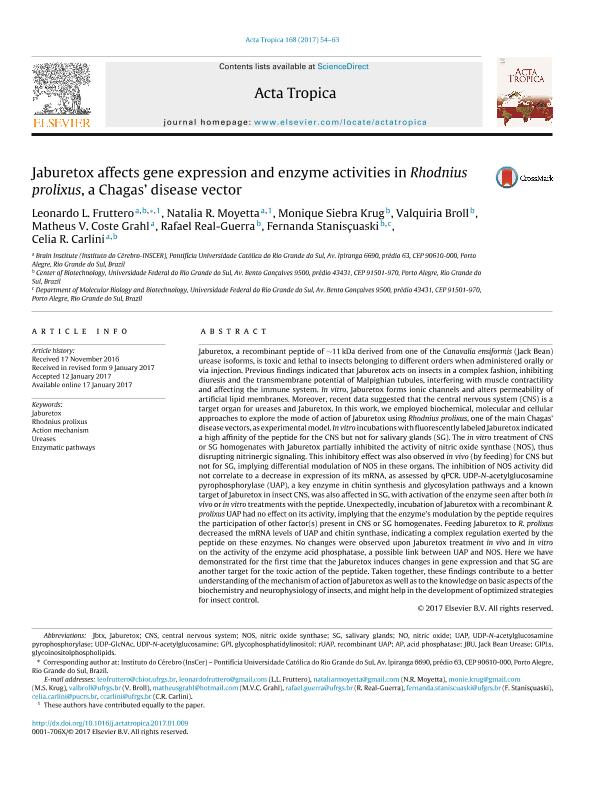Artículo
Jaburetox affects gene expression and enzyme activities in Rhodnius prolixus, a Chagas’ disease vector
Fruttero, Leonardo Luis ; Moyetta, Natalia Rita
; Moyetta, Natalia Rita ; Krug, Monique Siebra; Broll, Valquiria; Grahl, Matheus V. Coste; Real Guerra, Rafael; Stanisçuaski, Fernanda; Carlini, Célia Regina R S
; Krug, Monique Siebra; Broll, Valquiria; Grahl, Matheus V. Coste; Real Guerra, Rafael; Stanisçuaski, Fernanda; Carlini, Célia Regina R S
 ; Moyetta, Natalia Rita
; Moyetta, Natalia Rita ; Krug, Monique Siebra; Broll, Valquiria; Grahl, Matheus V. Coste; Real Guerra, Rafael; Stanisçuaski, Fernanda; Carlini, Célia Regina R S
; Krug, Monique Siebra; Broll, Valquiria; Grahl, Matheus V. Coste; Real Guerra, Rafael; Stanisçuaski, Fernanda; Carlini, Célia Regina R S
Fecha de publicación:
04/2017
Editorial:
Elsevier Science
Revista:
Acta Tropica
ISSN:
0001-706X
Idioma:
Inglés
Tipo de recurso:
Artículo publicado
Clasificación temática:
Resumen
Jaburetox, a recombinant peptide of ∼11 kDa derived from one of the Canavalia ensiformis (Jack Bean) urease isoforms, is toxic and lethal to insects belonging to different orders when administered orally or via injection. Previous findings indicated that Jaburetox acts on insects in a complex fashion, inhibiting diuresis and the transmembrane potential of Malpighian tubules, interfering with muscle contractility and affecting the immune system. In vitro, Jaburetox forms ionic channels and alters permeability of artificial lipid membranes. Moreover, recent data suggested that the central nervous system (CNS) is a target organ for ureases and Jaburetox. In this work, we employed biochemical, molecular and cellular approaches to explore the mode of action of Jaburetox using Rhodnius prolixus, one of the main Chagas’ disease vectors, as experimental model. In vitro incubations with fluorescently labeled Jaburetox indicated a high affinity of the peptide for the CNS but not for salivary glands (SG). The in vitro treatment of CNS or SG homogenates with Jaburetox partially inhibited the activity of nitric oxide synthase (NOS), thus disrupting nitrinergic signaling. This inhibitory effect was also observed in vivo (by feeding) for CNS but not for SG, implying differential modulation of NOS in these organs. The inhibition of NOS activity did not correlate to a decrease in expression of its mRNA, as assessed by qPCR. UDP-N-acetylglucosamine pyrophosphorylase (UAP), a key enzyme in chitin synthesis and glycosylation pathways and a known target of Jaburetox in insect CNS, was also affected in SG, with activation of the enzyme seen after both in vivo or in vitro treatments with the peptide. Unexpectedly, incubation of Jaburetox with a recombinant R. prolixus UAP had no effect on its activity, implying that the enzyme's modulation by the peptide requires the participation of other factor(s) present in CNS or SG homogenates. Feeding Jaburetox to R. prolixus decreased the mRNA levels of UAP and chitin synthase, indicating a complex regulation exerted by the peptide on these enzymes. No changes were observed upon Jaburetox treatment in vivo and in vitro on the activity of the enzyme acid phosphatase, a possible link between UAP and NOS. Here we have demonstrated for the first time that the Jaburetox induces changes in gene expression and that SG are another target for the toxic action of the peptide. Taken together, these findings contribute to a better understanding of the mechanism of action of Jaburetox as well as to the knowledge on basic aspects of the biochemistry and neurophysiology of insects, and might help in the development of optimized strategies for insect control.
Palabras clave:
ACTION MECHANISM
,
ENZYMATIC PATHWAYS
,
JABURETOX
,
RHODNIUS PROLIXUS
,
UREASES
Archivos asociados
Licencia
Identificadores
Colecciones
Articulos(CIBICI)
Articulos de CENTRO DE INV.EN BIOQUI.CLINICA E INMUNOLOGIA
Articulos de CENTRO DE INV.EN BIOQUI.CLINICA E INMUNOLOGIA
Citación
Fruttero, Leonardo Luis; Moyetta, Natalia Rita; Krug, Monique Siebra; Broll, Valquiria; Grahl, Matheus V. Coste; et al.; Jaburetox affects gene expression and enzyme activities in Rhodnius prolixus, a Chagas’ disease vector; Elsevier Science; Acta Tropica; 168; 4-2017; 54-63
Compartir
Altmétricas



